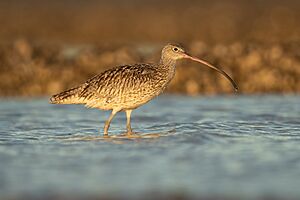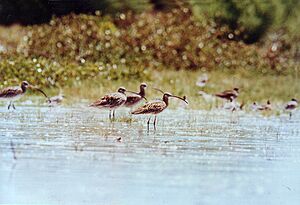Far Eastern curlew facts for kids
Quick facts for kids Far Eastern curlew |
|
|---|---|
 |
|
| Conservation status | |
| Scientific classification | |
| Genus: |
Numenius
|
| Species: |
madagascariensis
|
| Synonyms | |
|
Scolopax madagascariensis Linnaeus, 1766 |
|
The Far Eastern curlew (Numenius madagascariensis) is a really big shorebird. It looks a lot like the long-billed curlew, but it's even bigger! This bird is mostly brown. You can tell it apart from other curlews because its underwings are plain brown, without any patterns.
It's not just the biggest curlew; it might even be the biggest sandpiper in the world! These birds are about 60–66 cm (24–26 in) long. Their wings can spread out to about 110 cm (43 in) wide. They weigh between 565–1,150 g (1.246–2.535 lb). The Far Eastern curlew has a super long beak, measuring 12.8–20.1 cm (5.0–7.9 in). It's one of the longest beaks for any sandpiper!
Contents
Where They Live and What They Eat
Far Eastern curlews spend their breeding season in northeastern Asia. This includes places like Siberia and Mongolia. They like to build their nests in marshy areas, swamps, and near lakes.
When it's not breeding season, most of these birds fly to coastal Australia. Some also go to places like South Korea, Thailand, Philippines, and New Zealand. There, they hang out in estuaries, on beaches, and in salt marshes. During their long journey, they often stop to rest and eat on the mudflats of the Yellow Sea.
The curlew uses its long, curved beak to find food. It pokes its beak deep into the mud to search for small creatures. While it can feed alone, it usually gathers in large groups. This is especially true when they are migrating or resting. Their call is a sharp, clear whistle that sounds like cuuue-reee. They often repeat this sound.
What's on the Menu?
When Far Eastern curlews are in their breeding areas, they eat insects. This includes larvae of beetles and flies. They also enjoy small crustaceans called amphipods. During their migration, they sometimes eat berries too.
In the non-breeding season, they switch to eating sea creatures. They really like crabs and small molluscs. But they also eat other crustaceans and worms found in the mud.
Why They Need Our Help
The Far Eastern curlew is a bird that needs our protection. In 2006, there were only about 38,000 of these birds left in the world. Because their numbers are dropping, their status was changed to "vulnerable" in 2010. This means they are at risk of becoming endangered.
In Australia, the Far Eastern curlew is listed as "critically endangered." This is the highest level of risk.
What Threatens Them?
The main reason their population is shrinking is because of changes to their habitat. Many tidal flats along the coasts of the Yellow Sea have been taken over for other uses. These mudflats are very important. They are where the Far Eastern curlew stops to rest and eat during its long migration. More than 65% of these vital mudflats have been lost. This makes it very hard for the curlews to survive their journey.




